crossposted to ProgressiveBlue, Docudharma, The Hillbilly Report and Agent Orange.
 The people's choice award in the Re-Burbia "Rethinking Suburbia" design competition was the entry titled Urban Sprawl Repair Kit: Repairing The Urban Fabric.
The people's choice award in the Re-Burbia "Rethinking Suburbia" design competition was the entry titled Urban Sprawl Repair Kit: Repairing The Urban Fabric.But I want to adapt these ideas from the repair of the urban fabric to the original creation of a healthy suburban fabric. From further below:
After all, no matter how much one may love big cities - big cities have never been the be-all and end-all of settlement. Part of a healthy big city economy is a healthy network of relationships to a surrounding network of healthy smaller cities. And part of what makes them healthy is a healthy network of relationships to healthy small towns and villages.
And that is the foundation of the Suburban Town and Village design pattern, using the Rapid Streetcar as its transport infrastructure backbone: providing suburban Towns and Villages that work in their own right, replacing the two-dimensional movie-set facade of Town and Village life offered by most suburban sprawl communities.
____________________
The Urban Repair Kit shows thinking in line with the concept of "Retrofitting Suburbia" (or listen to Ellen Dunham-Jones speak at the annual CNU Illinois chapter meeting in Wheaton, IL on Friday, September 28th, 2007: mp3 #1 (overview), #2 (case studies: retrofitting in dying and thriving malls), #3 - and apologies for audio quality, direct your complaints to the Congress for New Urbanism).
 Aaron M. Renn, "The Urbanophile" raised five points in his review of Retrofitting Suburbia:
Aaron M. Renn, "The Urbanophile" raised five points in his review of Retrofitting Suburbia:
- The strategic dilemma I outlined at the top. When there is always a shinier, newer version of the 'burbs to be had, the clock starts ticking on your town the minute the ribbon is cut at the grand opening.
- The problem of overdetermined form. That is, the buildings of the suburbs, unlike those of the old city, are built with such a rigid "form follows function" design paradigm that they are difficult and expensive to retrofit for other uses. This isn't only a problem for the suburbs, but it's a bigger problem there.
- The 20 year depreciation cycle. Buildings, especially commercial structures, are built on a 20 or so year business case. Once the building hits the end of that useful life, it can be safely abandoned, with any salvage value as gravy. Which brings us to,
- The accumulation of unfunded liabilities. Enormous infrastructure and redevelopment costs, the legacy costs of our traditional cities for example, are created whenever you build a new town, but those liabilities are not funded. What's more, the liabilities attach to the land, not the people, so when the bill comes due, people can just move out, leaving behind an impoverished, decaying husk. It's like being able to run up a huge credit card bill in somebody else's name, then skip town.
- The fact that the vast bulk of suburbs are shadow cities. Many of them take steps to explicitly keep out the types of people and businesses that would produce the economic conditions necessary to be a true city. This renders them highly vulnerable to obsolescence.
Now, to be fair to June Williamson and Ellen Dunham-Jones, they are discussing the retrofit of the Suburban Form, and the suburban form has been a dominant development style in inner suburbs and what are now quite urbanized areas as well as in the outer suburban fringe and communities that remain very much stereotypical bedroom suburbs.
 However, its pioneering in outer suburbia and the stereotypical bedroom communities that is my focus here. If we have a design pattern that can be established in outer suburbia, can be reproduced in outer suburbia, and offers the opportunity for ecologically sustainable settlement in outer suburbia - then the massive amount of capital investment in outer suburbia over the past thirty years no longer acts to lock us into an unsustainable economy.
However, its pioneering in outer suburbia and the stereotypical bedroom communities that is my focus here. If we have a design pattern that can be established in outer suburbia, can be reproduced in outer suburbia, and offers the opportunity for ecologically sustainable settlement in outer suburbia - then the massive amount of capital investment in outer suburbia over the past thirty years no longer acts to lock us into an unsustainable economy.In short, the current design pattern for outer suburbia acts like a Berlin Wall between where we are and where we need to go, and the hope is to find a reproducible design pattern that acts to open the existing locked gates in that wall and to build new open gates in.
The design pattern I am focusing on here is the Suburban Town and Village pattern built around a Rapid Streetcar corridor.
 A Rapid Streetcar, at least as used here (and I'll note that its a loose term) is what is called a "tram-train" in Europe. In the European context, there is a languishing or abandoned streetcar system in a smaller regional city. It suffers in loss of patronage because of the move of much of its former professional commuters from the central city to the suburbs. Faced with a drive to a park and drive train station, then a transfer to a streetcar, then a walk to the office - quite often, they just stay in the car and drive to the office.
A Rapid Streetcar, at least as used here (and I'll note that its a loose term) is what is called a "tram-train" in Europe. In the European context, there is a languishing or abandoned streetcar system in a smaller regional city. It suffers in loss of patronage because of the move of much of its former professional commuters from the central city to the suburbs. Faced with a drive to a park and drive train station, then a transfer to a streetcar, then a walk to the office - quite often, they just stay in the car and drive to the office.So the innovative solution was to revive the use of the smaller Streetcar network by making a Rapid Streetcar that can run from the streetcar line directly onto the regular rail corridor so that people can catch the Streetcar near to where they live, and take a single ride into the destination. This allows them to avoid the hassle of both peak hour traffic and of finding parking in town, and the revived streetcar line allows them to get around town, avoiding the traffic and parking hassles there as well.
Now, take the classical divided-use American Suburbia. There is a commercial district somewhere - suburban zoning demands it, since commercial property cannot be mixed indiscriminately into the dominant single residence per lot residential zone. That commercial district has a massive amount of "grayfield" allocated to parking. Indeed, by design, more parking is available than the total number of cars that will regularly visit the zone, because each commercial property must have enough parking for the peak parking demand time of day for the peak parking demand time of year.
Imposing that parking requirement on developers ensures that parking will be "free", which is to say that the cost of the parking is transferred by government fiat from the users of the parking to all customers of the businesses. And of course, the massive oversupply of parking ensures that commercial establishments are so widely separated that it is hard to access the
businesses except by car.
This is, of course, a gross economic inefficiency. The massive wasted space imposed extra costs are generated and imposed on the small minority of users that do not, in the circumstances often because they can not, drive. But that is not a cross-subsidy to the drivers, because the drivers shoulder the majority of the hidden cost of "free" parking. Since there is a massive oversupply in total available parking spaces, this system imposes extra costs on motorists while at the same time it creates additional costs that are imposed on non-motorists.
Mining that gross economic inefficiency is the key to the Suburban Town side of the Suburban Town and Country design pattern.
 A streetcar line is laid out along a length of the commercial zone, which is redeveloped into a mixed used zone by infill grayfield development, adding mixed use office and residential buildings. It can focus on being walkable extending out from the Streetcar line. Parking is available at opposite ends of the Streetcar line, and of course use of the Streetcar is far along that part of the line.
A streetcar line is laid out along a length of the commercial zone, which is redeveloped into a mixed used zone by infill grayfield development, adding mixed use office and residential buildings. It can focus on being walkable extending out from the Streetcar line. Parking is available at opposite ends of the Streetcar line, and of course use of the Streetcar is far along that part of the line.Pooled parking means that one parking space can be used for visits to multiple stores, whether Big Boxes, new street level stores, or stores inside a conventional shopping mall - and one parking space can be used for different purposes. Freeing the parking space from the service of a single establishment by itself frees up parking.
Of course, its not possible to stop here. What has been done so far is recreating the conditions of the languishing and abandoned streetcar lines in small European cities. The streetcar line in this suburban context is simply too short and provide direct start-to-finish trips to too few people to justify its existence. And yet, without the modern, low floor Streetcar running largely unimpeded by traffic - the pooling of parking does not work.
Which is where the other side of the Rapid Streetcar line comes in. At the end of the one or two mile streetcar route, the streetcar does not turn around and head back the other way. It goes into a regular rail corridor (either existing or revived) and runs to the next Suburban Town - and eventually runs into the closest genuine urban area as an anchor to the line.
 And along the corridor, stations are established. And around these stations is a zoning easement that allows the development of Suburban Villages. For example:
And along the corridor, stations are established. And around these stations is a zoning easement that allows the development of Suburban Villages. For example:- Within a half mile radius of the station
- no height limit may be imposed below three stories;
- no multiple-residence limits below four residences per lot may be imposed;
- The front setback is reduced to the width of a broad sidewalk, which new development must provide;
- The side setback is limited to transport easement
- Parking requirements on new developments are scaled to average car ownership
of residents
- Within a quarter mile radius:
- Ground floor commercial and professional property is permitted on any lot that retains residential property,
- All parking requirements may be met with common pooled parking.
Note that this is all freedom to develop a walkable suburban village center. No change at all is mandated here, but station is only provided if mixed use, infill development in its vicinity is allowed.
Oh, and the Rapid Streetcar running as a local train does require the passenger to pay a fare. The intervals between the Streetcar sections through either the newly retrofitted Suburban Town Centers, as well as the centers of existing town, provides easily understood intervals for a simple zone based ticket structure. To encourage use of the Rapid Streetcar outside the peak commute period, when boarding between the morning commute and evening commute, or after the evening commute, a return ticket costs only 20% more than a regular one-way ticket.
So this is the design pattern: a stretch of Streetcar line running through the town center of a newly retrofitted "New Suburban Town" or an existing town center that pre-dated the rise of the surrounding suburbs. Between stretchs of Streetcar line, a local rail line connecting stations, each of which is the potential center for a Suburban Village Center.
Now to run this through the challenges raised by "The Urbanist".
Challenge One: The Lure of the Shiny and New
Challenge #1: The Newer Shinier suburb. Clearly, where the development itself is occuring is a "newer, shinier" suburb.
This is secondary part of the response, however. Consider the five mile band along either side of the Rapid Streetcar line. If two Streetcar zones are thirty miles apart, and the corridor stations are five to six miles apart, that is one Streetcar section and four Suburban Village easements in a 300 square mile area. A quarter mile both sides of a two mile Streetcar segment and four half-mile radius easements is about four square miles of infill development opportunities - only 1.3% of the total. In terms of residences, it may be more, especially in the Suburban Village Centers, but in any event under 5%.
However, two miles is not an imposed ride for even a casual transport cyclist going at low speed. A two mile "causal cycling" band around the streetcar line and a two mile radius around each suburban village is 70 square miles, 23% of the five mile wide band.
And of course, five miles is a short trip for an electric bike at 20mph or a Neighborhood Electric Vehicle at 30mph - so the Rapid Streetcar line and each commercial site along its length is within ease access of an electric bike or Neighborhood Electric Vehicle anywhere along the 5 mile wide band.
So:
- 1.3% walkable development
- =23% cycleable suburbs
- = 100% suburbs supporting inexpensive electric vehicles
Note here that there is no new technology required for the option of all-electric transport anywhere within reach of the Rapid Streetcar line - five miles is so far within the round trip radius of existing e-bikes and NEV's that the user would not even need to recharge each day. And if there is bike and NEV parking with debit/credit card activated recharge plugs, some users could find that they rarely need to recharge at home. For longer trips along the line, just take the streetcar.
This is new in a way that just one more suburb further out into outer suburbia cannot match. Its still suburban, of course - just done drive through the Suburban Town Center or Village Center, and you are driving through normal suburbia. Except normal suburbia with fewer cars on the road, because fewer people have to drive everywhere they go, and fewer people have to drive between different stops on the same trip.
But its suburbia that allows gasoline-free transport and offers the option of walkable districts surrounded (automatically) by a substantial cycle-able fringe. That's awfully shiny and new.
Challenge Two: Overdetermined Form
This shiny and new happens for the vast majority of property in the area as a result of "a changing vicinity". So those properties do not need to change in form. The initial infill development in the retrofitted Suburban Town Centers takes place primarily in existing grayfield parking lots. It is, then, only the Suburban Village Centers that are likely to experience substantial rebuild from the ground up redevelopment - and this redevelopment will occur incrementally over time.
Challenge Three: The 20 Year Development Cycle
Given commercial interest rates, value thirty years in the future offers such a small increment in present value that buildings are quite often not built to last that long.
For this design pattern, this is not a problem - its an opportunity. It ensures that after the first wave of grayfield development takes place in the Suburban Town Center, there is a steady supply of opportunities for additional infill development, as Big Boxes and enclosed malls reach the end of their planned lifespan. The availability of the Streetcar line permits denser redevelopment and the original upgrade to mixed-use zoning means that the denser redevelopment is not restricted to the floorspace required by the (now larger) number customers that can be channeled into the area, but build upon that while including residential development.
Challenge Four: Unfunded Liabilities
The core problem here, recall, is that "... the liabilities attach to the land, not the people, so when the bill comes due, people can just move out, leaving behind an impoverished, decaying husk. It's like being able to run up a huge credit card bill in somebody else's name, then skip town."
Mining existing economic inefficiencies to boost development means there is growth in value to help share this burden. And this is true even in the context of a stable economy rather than a growth economy. Rather than suffering through an ongoing decline in real property values, this provides the basis for experiencing an increase in real property values. And in the face of an increase in real property values, there are far more opportunities to find funding for presently unfunded liabilities.
Indeed, one of sources of the unfunded liabilities, and a major inefficiencies of sprawl development, is the cross-subsidy by more densely populated areas of new sprawl development that automatically follows charging a flat rate for utility hook-ups. Given the infill nature of the new development taking place in this design pattern, that can be reversed with the full support of infill developers by establishing a system of hook-up discounts for new developments that are more compact than the existing area average. Given cost-plus hook-up charges, this can largely eliminate the inefficient cross-subsidy.
Challenge Five: The Shadow City
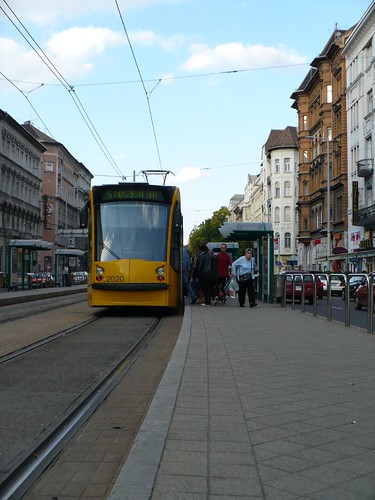 The problem here is that: "the vast bulk of suburbs are shadow cities. Many of them take steps to explicitly keep out the types of people and businesses that would produce the economic conditions necessary to be a true city. This renders them highly vulnerable to obsolescence."
The problem here is that: "the vast bulk of suburbs are shadow cities. Many of them take steps to explicitly keep out the types of people and businesses that would produce the economic conditions necessary to be a true city. This renders them highly vulnerable to obsolescence."In this design pattern, the majority of the service area of the Rapid Streetcar line can, in fact, continue to act as a Shadow City. However, embedded within the service area is a small city. The small city is not in the familiar compact form, but is instead in network form. And of course, while the big city may be some distance away, it is also within walking distance, either directly via the Rapid Streetcar line, or via a transfer at the Intercity High Speed Rail corridor.
After all, no matter how much one may love big cities - big cities have never been the be-all and end-all of settlement. Part of a healthy big city economy is a healthy network of relationships to a surrounding network of healthy smaller cities. And part of what makes them healthy is a healthy network of relationships to healthy small towns and villages.
And that is the foundation of the Suburban Town and Village design pattern, using the Rapid Streetcar as its transport infrastructure backbone: providing suburban Towns and Villages that work in their own right, replacing the two-dimensional movie-set facade of Town and Village life offered by most suburban sprawl communities.
Of course, none of this contradicts the New Urbanism within the Urban environment. Because of its massive space inefficiencies, Suburban Form does not fit into the Urban environment, and where it has been imposed on the Urban Environment, it truly is necessary to repair the fabric.
Its just that Suburban Form does not actually work for sub-urban living either. We just have been able to pretend it does because we have had massive amounts of energy to throw at the inefficiencies. However, if we are regain our Energy Independence, we no longer have the luxury of pretending that the standard Suburban Forms actually function well for sub-urban living.
So in the end, the idea is to go into the sterile fields of astroturf planted with artificial silk trees, and start the process of growing real grass and real trees.
Proper Soil Conditions
This is a Seeds of Development strategy, and like any seed, these design patterns obviously require the proper soil conditions for, first, becoming established and, second, growing and reproducing.
Part of the soil conditions are already in place. There are a large number of commercial suburban areas that have been placed into stress by the over-saturation of the market for shopping malls, and businesses that might oppose such an innovation during normal times are far more likely to embrace it, if it appears to be an alternative to bankruptcy.
Another part of the soil conditions will require a Federal fight, but once we have won it, it can then play its part coast to coast.
In Europe, most bulk freight is carried by ship and canal barge, and passenger services are a much larger share of the work of national rail networks. Building a version of a Streetcar that is able to operate on a European rail network is a much more straightforward task than building a Streetcar that is able to operate alongside American coal trains.
The straightforward solution is, of course, "don't do that". We operate in the US with a myth of a single network standard for rail operations. Except the standard, oriented as it is to the needs of freight railroads focusing on massive bulk freight loads, is not in fact compatible with the needs of all rail users.
The answer here is to recognize the need for the kind of rail network and network regulation that we have, but also recognize that there is a substantial benefit for a wide range of potential rail users if they do not have to design against the risk of being rammed into by a coal train, and provide a second network standard - what I have normally called "Rapid Rail" as opposed to "Heavy Rail". Axle load limits would be lower, positive train control would be required, a 2.5% (1:40) gradient would be allowed instead of the Heavy Rail 1% (1:100) for less expensive and intrusive overpasses and underpasses.
A side-effect of the Rapid Rail network is that this is the design challenge that the European Rapid Streetcars have already met, so a Rapid Rail corridor could be shared by Rapid Streetcars, conventional express passenger rail, as well as medium freight, to take full advantage of the substantial transport capacity represented by a single rail line.
The third condition are the Suburban Village easements described above. These cannot be readily adopted at a Federal Level - but they can be adopted at a State level. After all, county and city zoning powers ultimately derive from State power in our Federal system. A state could create this easement for any rail corridor station that includes state funding. Indeed, a state could create this easement for any rail corridor station funded by any state or local tax or public fee.
And not only could, but has both strong public policy and public finance reasons for doing so. The public policy interest is simply that the benefit provided by a station is determined by the residents in its service area, and the by the range of destinations that it offers. So zoning restrictions in the local vicinity of a corridor station that restrict residential density and commercial and professional uses restrict the benefit of the station, and are therefore undermining the benefit/cost of the use of public funds.
What a zoning easement does in commercial terms is to create new value to the extent that it permits something that was not permitted before and which has more value per acre than what was permitted before. So a zoning easement can be associated with an incremental development levy for development that has recourse to the easement. This is a tax that existing property owners only ever pay if the easement increases the value of their property for development by more than the levy. So if the levy is tied to the increment in property value at the new development and property outside the easement zone, its always a capital gains tax on capital value created by easing the zoning restriction.
If the state share of the rail infrastructure is funded out of general revenue bonds, the capital levy can acquire the revenue bond, which can then be used to finance new capital works without requiring new bonds to be issued.
Which is to say, more ground breaking ceremonies and more ribbon cutting ceremonies from the same revenue bonds by capturing part of the increase in value created by the infrastructure.
Combine these three soil conditions - local developers itching for work and commercial establishments looking to stave off decline, the opportunity to run Rapid Streetcars from short sections of dedicated Streetcar line into shared rail infrastructure, and State zoning easements around corridor stations tied to developer levies within the easement zones - and that would put us in a position of looking to start planting.
Midnight Oil: Dead Heart (Unplugged)
...
We carry in our hearts the true country
And that cannot be stolen
We follow in the steps of our ancestry
And that cannot be broken
We don't need protection
Don't need your land
Keep your promise on where we stand
We will listen we'll understand
Mining companies, pastoral companies
Uranium companies
Collected companies
Got more right than people
Got more say than people
...
 As people look back to the decade just past, and as we look ahead to the long, hard job ahead of us, many people describe the decade in many different ways - tumultuous, chaotics, catastrophic, liberating, tragic, joyous - but it seems that nothing recycles so easily as a phrase, and so the punditry online seem to have settled on The Roaring Teens.
As people look back to the decade just past, and as we look ahead to the long, hard job ahead of us, many people describe the decade in many different ways - tumultuous, chaotics, catastrophic, liberating, tragic, joyous - but it seems that nothing recycles so easily as a phrase, and so the punditry online seem to have settled on The Roaring Teens.
 And it maybe that they would not have acted quite as they did, but the Federal Reserve controversy of the summer of 2011 broke out, starting as a gambit aiming for some advantage in some long forgotten policy fight over whether to do too little, too late, both, or nothing at all. And they were faced with the choice of whether to keep sliding their peg - and what they knew that would mean for domestic inflation, given their need for dramatically larger coal imports from the United States to tide them over as they kept ramping up their New Energy power sources.
And it maybe that they would not have acted quite as they did, but the Federal Reserve controversy of the summer of 2011 broke out, starting as a gambit aiming for some advantage in some long forgotten policy fight over whether to do too little, too late, both, or nothing at all. And they were faced with the choice of whether to keep sliding their peg - and what they knew that would mean for domestic inflation, given their need for dramatically larger coal imports from the United States to tide them over as they kept ramping up their New Energy power sources. As Jon Stewart asked, "Why do they call it floating when all we are doing is sinking?" - leading, lest we forget, to calls for his resignation and return to the Comedy Channel from the ever more strident and ever less relevant conservative movement.
As Jon Stewart asked, "Why do they call it floating when all we are doing is sinking?" - leading, lest we forget, to calls for his resignation and return to the Comedy Channel from the ever more strident and ever less relevant conservative movement. A critical part of the Victory Parade coalition had been from Great Lakes and Midwestern states battered by two decades of import-for-profits "globalization", clinging desperately to the slender reed of hope offered by so-called "Green Jobs". Those policies seemed like more too little, too late on their own. But they met the rising tide of US$ oil prices, the wave of Chinese take-overs of US coal companies aiming at shifting US coal to export markets, the export boom, and US production capacity started growing at headlong rates.
A critical part of the Victory Parade coalition had been from Great Lakes and Midwestern states battered by two decades of import-for-profits "globalization", clinging desperately to the slender reed of hope offered by so-called "Green Jobs". Those policies seemed like more too little, too late on their own. But they met the rising tide of US$ oil prices, the wave of Chinese take-overs of US coal companies aiming at shifting US coal to export markets, the export boom, and US production capacity started growing at headlong rates. The "Victory Parade", after all, primarily involved Eurasia. We left Japan, but not Australia. We left Europe, but our presence in southern Africa grew. Most Caribbean states would be hard pressed to pin point the fall of the American Empire, since it feels like no such thing in Jamaica or Trinidad. Even today, the Department of the Navy oversees the largest navy on the face of the globe,dominating the Caribbean, west and south Atlantic, the east and south Pacific. The Department of War oversees bases on four continents.
The "Victory Parade", after all, primarily involved Eurasia. We left Japan, but not Australia. We left Europe, but our presence in southern Africa grew. Most Caribbean states would be hard pressed to pin point the fall of the American Empire, since it feels like no such thing in Jamaica or Trinidad. Even today, the Department of the Navy oversees the largest navy on the face of the globe,dominating the Caribbean, west and south Atlantic, the east and south Pacific. The Department of War oversees bases on four continents. And of course, Climate Chaos presses us ever harder. Certainly, we seem better placed to address it than it ever seemed we would, especially following the nationalization of US coal mines, and the "Two Centuries of Coal" conservation strategy that followed.
And of course, Climate Chaos presses us ever harder. Certainly, we seem better placed to address it than it ever seemed we would, especially following the nationalization of US coal mines, and the "Two Centuries of Coal" conservation strategy that followed.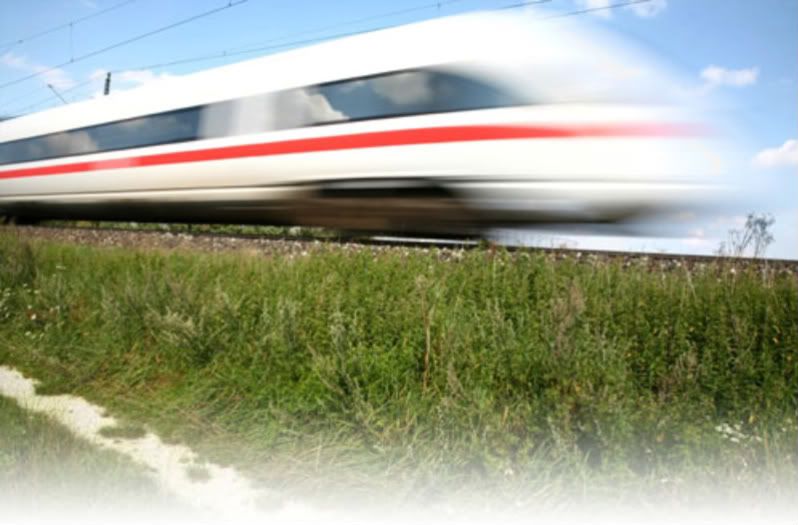 On Thursday,
On Thursday, 
 But its not the only thing that threatens much of this. Peak Oil will have much the same effects, especially in today's high income nations that are so dependent on an energy-intensive technology, and especially in the United States which is
But its not the only thing that threatens much of this. Peak Oil will have much the same effects, especially in today's high income nations that are so dependent on an energy-intensive technology, and especially in the United States which is 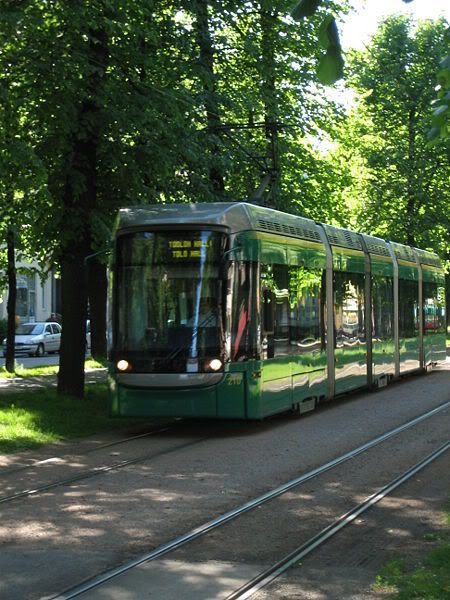 Passenger and Freight Transport systems are one part of the Good Economy that touches on all levels. It is not unique in this - information systems are a similar example. So, no, I am not focusing on Good Transport because it is sufficient for a Good Economy, but because it is necessary for a Good Economy. We have a wide range of things we have to do to have a Good Economy - but we cannot build the systems we have to have in abstract sweeping terms. To get into the nitty gritty, its necessary to talk about something in particular.
Passenger and Freight Transport systems are one part of the Good Economy that touches on all levels. It is not unique in this - information systems are a similar example. So, no, I am not focusing on Good Transport because it is sufficient for a Good Economy, but because it is necessary for a Good Economy. We have a wide range of things we have to do to have a Good Economy - but we cannot build the systems we have to have in abstract sweeping terms. To get into the nitty gritty, its necessary to talk about something in particular.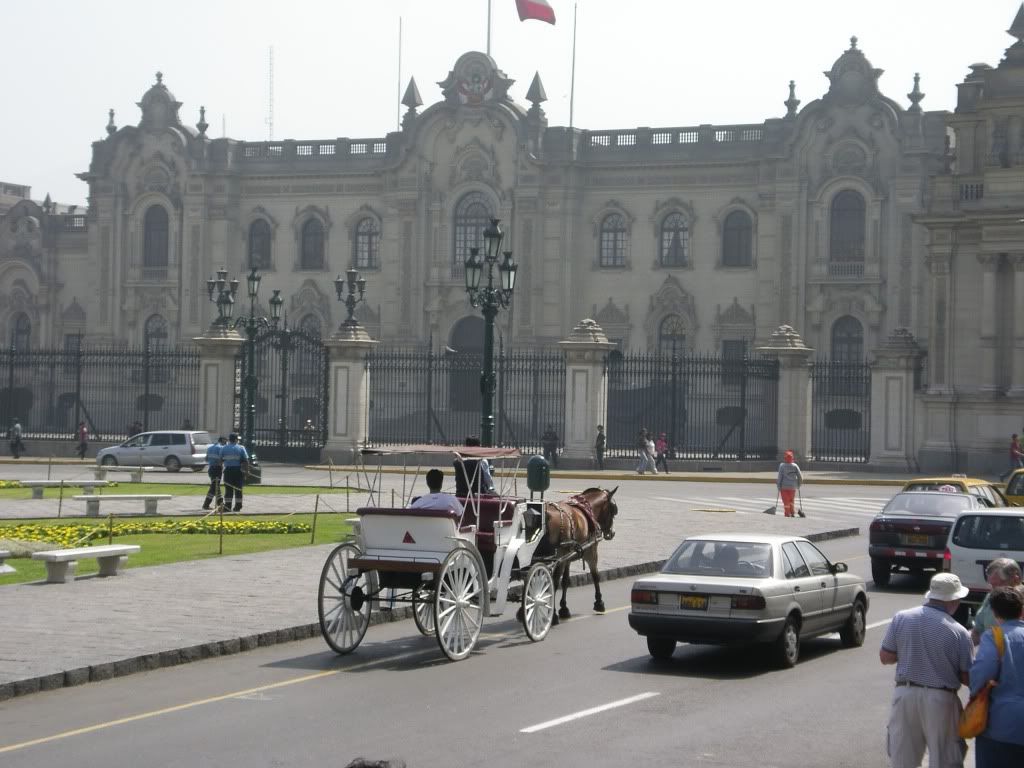 But there will still be something we recognize as a car. We had carriages serving a similar role before the age of fossil fuels, and the initial rise of rail in the Age of Coal led to a growth in their use, not a decline. And while there may be an increased reliance in horse drawn transport in some rural areas, we cannot build our urban transport systems on the miserable conditions that so many horses suffered under in 19th century cities. So electric or internal combustion or some mix of the two, we will continue to use horseless carriages.
But there will still be something we recognize as a car. We had carriages serving a similar role before the age of fossil fuels, and the initial rise of rail in the Age of Coal led to a growth in their use, not a decline. And while there may be an increased reliance in horse drawn transport in some rural areas, we cannot build our urban transport systems on the miserable conditions that so many horses suffered under in 19th century cities. So electric or internal combustion or some mix of the two, we will continue to use horseless carriages. From one of
From one of 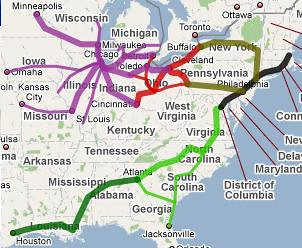 The increasingly
The increasingly  Modifying the original trunks to fit this existing proposal results in one trunk that completes the circle around Appalachia and one that cuts through Appalachia running from the Northeast toward the Southwest. Also shown is the existing conventional rail Amtrak route from DC to Chicago via Charleston, WV.
Modifying the original trunks to fit this existing proposal results in one trunk that completes the circle around Appalachia and one that cuts through Appalachia running from the Northeast toward the Southwest. Also shown is the existing conventional rail Amtrak route from DC to Chicago via Charleston, WV.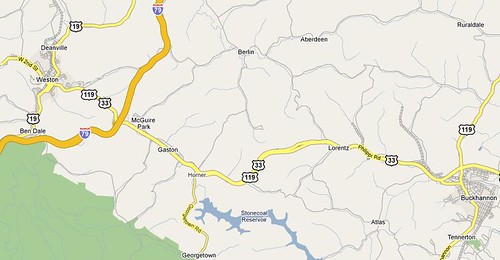 The result is that often you have rail lines that are not all that far apart, on a straight line path, but one rail line connects to the north (the lines that run up through Weston in the map), the other rail lines connects to the south (the lines that run through Buckhannon in the map), and they do not connect.
The result is that often you have rail lines that are not all that far apart, on a straight line path, but one rail line connects to the north (the lines that run up through Weston in the map), the other rail lines connects to the south (the lines that run through Buckhannon in the map), and they do not connect. Stage Two is a service from Charleston to the West, collecting westbound passengers from the existing (but more reliable, faster, and more frequent) DC/Chicago service and collecting eastbound passengers. Further west, the alignment crosses existing planned 110mph Higher Speed routes, ending in Saint Louis (Note that while I have traced out an existing rail right of way, it is not shown in the schematic).
Stage Two is a service from Charleston to the West, collecting westbound passengers from the existing (but more reliable, faster, and more frequent) DC/Chicago service and collecting eastbound passengers. Further west, the alignment crosses existing planned 110mph Higher Speed routes, ending in Saint Louis (Note that while I have traced out an existing rail right of way, it is not shown in the schematic).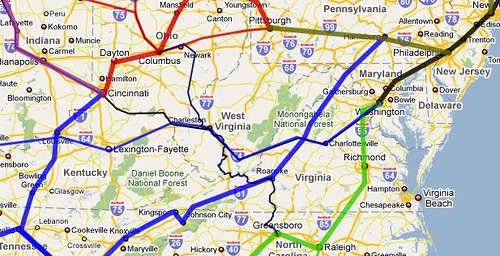 Stage Three offers to fill this hole by extending that corridor down to Athens, Ohio, and then on to Charleston, WV, to share the NYC/DC/WV/IN/Chicago corridor and then cross to Roanake, terminating at Greensboro on the Southeast Express Corridor. Note that the route appears more irregular since the pictured route more closely follows existing rights of way - and that this is definitely terrain where operating a conventional passenger service rather than a tilt-train would be a mistake even if a maximum speed limit of 79mph or 90mph is applied.
Stage Three offers to fill this hole by extending that corridor down to Athens, Ohio, and then on to Charleston, WV, to share the NYC/DC/WV/IN/Chicago corridor and then cross to Roanake, terminating at Greensboro on the Southeast Express Corridor. Note that the route appears more irregular since the pictured route more closely follows existing rights of way - and that this is definitely terrain where operating a conventional passenger service rather than a tilt-train would be a mistake even if a maximum speed limit of 79mph or 90mph is applied.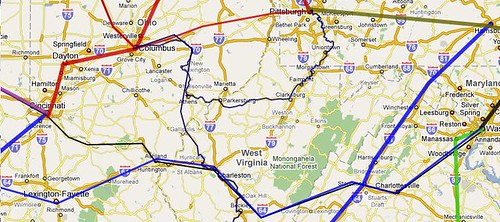 The "Mountaineer" connects Parkersburg, Clarksburg, Fairmont, and Morgantown to Columbus via Athens and Pittsburgh via Uniontown. With the Columbus/Greenboro line, a passenger can transfer at Athens between Charleston and points to the Southeast and West Virginia towns along the Mountaineer. Note that this corridor looks even squigglier, in large part because the process of lining it up along existing rail rights of way (for estimating route-miles for a later essay) is almost complete - but also because the terrain means that most through rail corridors run along fairly narrow river valleys.
The "Mountaineer" connects Parkersburg, Clarksburg, Fairmont, and Morgantown to Columbus via Athens and Pittsburgh via Uniontown. With the Columbus/Greenboro line, a passenger can transfer at Athens between Charleston and points to the Southeast and West Virginia towns along the Mountaineer. Note that this corridor looks even squigglier, in large part because the process of lining it up along existing rail rights of way (for estimating route-miles for a later essay) is almost complete - but also because the terrain means that most through rail corridors run along fairly narrow river valleys. \From some online dictionary somewhere:
\From some online dictionary somewhere: David Axelrod made the case for insisting on the public option if there is an individual mandate to buy from health insurance exchanges, on the
David Axelrod made the case for insisting on the public option if there is an individual mandate to buy from health insurance exchanges, on the  Is the "health care crisis" that 100,000 people a year are dying preventable deaths, or that the health care and health insurance cost explosion is interfering with other corporations in their pursuit of profit?
Is the "health care crisis" that 100,000 people a year are dying preventable deaths, or that the health care and health insurance cost explosion is interfering with other corporations in their pursuit of profit?
